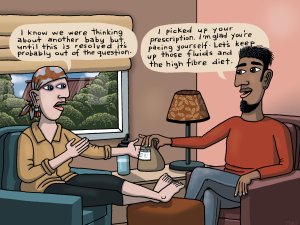Academic pharmacist Nataly Martini highlights the importance of understanding non-Hodgkin lymphoma and pharmacists’ roles in managing this condition
Reduce the risk of sore throat progressing to rheumatic fever
Reduce the risk of sore throat progressing to rheumatic fever

SIONE BRINGS HIS six-year-old son, Maleko, into your pharmacy and asks you for something for his throat. He says he’s been complaining about it for days and hasn’t been able to swallow much. When you ask Maleko how he is feeling, he says his throat is super sore and his voice sounds husky. You know the family is not financially well off and have had some challenges with housing.
In approximately 0.3 to 3 per cent of people, strep throat may lead to acute rheumatic fever
Viruses account for most cases of sore throat, but 15 to 30 per cent of sore throats in children and 10 per cent in adults are estimated to be caused by a bacterium called Streptococcus pyogenes, also called group A Streptococcus (GAS). GAS sore throats (GAS pharyngitis) are colloquially known as strep throats.1,2
In approximately 0.3 to 3 per cent of people, strep throat may lead to acute rheumatic fever (commonly called rheumatic fever). Rheumatic fever is an autoimmune inflammatory disease that can affect the joints, skin and brain, and it can cause lasting damage to the heart.
While most other developed countries have virtually eliminated rheumatic fever, New Zealand still maintains a high prevalence. Pacific peoples have the highest rates of initial attacks (32.9 cases per 100,000 people), followed by Māori (13.8 per 100,000 people), with 88 per cent of new cases in the Auckland region occurring in school-aged children. Māori and Pacific children account for 95 per cent of hospital admissions for first episodes of rheumatic fever in the five to 14-year age group. The main areas of occurrence are the lower socioeconomic areas of the North Island, such as parts of Auckland, Waikato, Northland, Bay of Plenty, Rotorua, Gisborne, Hawke’s Bay and Porirua.1
The most common symptoms of a sore throat include:2
- pain or a scratchy feeling at the back of the throat
- a dry and red-looking throat with inflamed and swollen tonsils
- a husky or hoarse-sounding voice
- pain when swallowing food or drinking
- enlarged and tender lymph nodes in the neck that are easily felt.
Sore throats caused by viral infections may also be accompanied by a cough, conjunctivitis or a runny nose.2
Unfortunately, there are no reliable signs or symptoms that distinguish strep throat from a viral sore throat. Some people are carriers of GAS in their throat and have no symptoms but can pass the bacterium on to other members of their household or school, who may develop symptoms.1,2
Symptoms of rheumatic fever include fever; painful, tender joints; chest pain; shortness of breath; tiredness; and jerky, uncontrollable body movements. Rarely, painless lumps (nodules) may develop near joints, or a rash may form that has pink rings with a clear centre.3
People cannot catch rheumatic fever from someone else because it is an autoimmune response, rather than an infection, but the bacterium can be passed easily from one person to another. Other than a sore throat, GAS also causes scarlet fever and impetigo, which may also lead to rheumatic fever. You should be alert for these other conditions and promptly refer the person to a doctor for antibiotic treatment. It can take one to five weeks after one of these infections for rheumatic fever to develop.1,3
Scarlet fever is when a strep throat infection is accompanied by a rash that feels rough to the touch and usually starts on the neck and chest and eventually spreads to the whole body. The rash is caused by toxins produced by the streptococcal bacteria.2
Impetigo is a common skin infection that typically starts as reddish sores around the nose and mouth or hands and feet, which then burst within a week, developing honey-coloured crusts. It is highly contagious and mainly affects infants and young children.4
In New Zealand, two risk populations have been identified: those at high risk of rheumatic fever and those at low risk.1
High-risk populations include people who have already had rheumatic fever or who live with someone who has had it. Other people at high risk include those who fit two or more of the following criteria:1
- Māori or Pacific ethnicity
- age three to 35 years (especially age four to 19 years)
- crowded living circumstances
- lower socioeconomic status.
Low-risk populations include those who:1
- are non-Māori and non-Pacific
- are children under three years old
- are adults older than 35 years
- do not live in crowded circumstances
- do not live in lower socioeconomic areas of the North Island
- have no personal, family or household history of rheumatic fever.
Learn to recognise who is more at risk of strep throat as prompt treatment substantially reduces the occurrence of rheumatic fever.1,2
Free sore throat clinics for children are available in some areas, details of which can be found by phoning Healthline on 0800 611 116. You should immediately refer any high-risk person with a sore throat, especially children and young adults, to one of these clinics or a doctor. People at low risk of rheumatic fever should be advised to monitor their symptoms and to see a doctor if they worsen or don’t resolve within three to five days.1
Referral may also be the best course of action for people who work in settings where the risk of transmission of GAS is high, such as childcare workers, food handlers, health and residential care workers, people in the New Zealand Defence Force, students living in shared accommodation, and teachers.1,2
The best way to diagnose strep throat is with a throat swab that is rubbed over the back of the throat and tonsils by a healthcare provider and then cultured in a laboratory and analysed for the presence of bacteria.1
Although rapid antigen tests for GAS are available in New Zealand, their accuracy can be affected by operator experience and the interpretation of test results. Positive RATs are not always associated with positive cultures.1
If somebody is at high risk, tell them to avoid taking NSAIDs, such as ibuprofen, until they have seen a doctor or clinic nurse because these can mask the symptoms of a strep throat and affect test results.1
In people at high-risk of rheumatic fever, antibiotics may be started before the results of a throat swab come back, especially if follow-up is problematic. The antibiotics can be stopped if the swab is negative. However, to avoid the overuse of antibiotics, waiting for the results before starting treatment is still recommended, as long as results are expected back in a timely manner.
Phenoxymethylpenicillin and amoxicillin are the recommended antibiotics, with erythromycin used for those with penicillin allergies. Advise people to stay at home for at least 24 hours after starting antibiotics to reduce the risk of GAS spread.1,2
Rheumatic fever is extremely uncommon in people at low risk who are non-Māori and non-Pacific, and doctors may be reluctant to prescribe antibiotics for a sore throat. However, if your customer’s symptoms persist or worsen, encourage them to visit their doctor again.1,2
For people at low risk, treatment for a sore throat may include:2
- oral ibuprofen – better at relieving inflammation than paracetamol
- iodine-based sore throat gargles – may kill viruses and bacteria associated with a sore throat but offer little symptom relief
- sore throat lozenges – the action of sucking promotes saliva flow, which lubricates and soothes inflamed tissue
- anaesthetic lozenges or spray, such as lidocaine – numbs the back of the throat
- topical NSAIDs such as flurbiprofen or benzydamine – act directly on the back of the throat, relieving pain and inflammation
- honey and honey-containing lozenges – good for soothing the throat
- natural remedies such as sage, marshmallow and echinacea.
MALEKO HAS THREE FACTORS that put him in a high-risk category for developing rheumatic fever: his age, he is of Pacific ethnicity, and his challenging living circumstances. You find the phone number and address of the sore throat clinic in your area and give them a call – they can see Maleko today. He returns with his Dad a few hours later with a prescription for antibiotics and ibuprofen. You tell Sione that Maleko should stay home for at least 24 hours (preferably longer), rest, and eat cool soft food, such as smoothies or soup. You explain that his sore throat is very infectious; he should avoid being too close to others and wash his hands frequently. If other household members develop symptoms, they should also go to the clinic.
This case study is hypothetical and does not represent a living, identifiable person
Carmen Pope (née Fookes) is a clinical pharmacist and Healthcare Handbook technical editor
This article forms part of the Healthcare Handbook Education Path. Once you have read this article on sore throats and rheumatic fever, read the corresponding chapter “Sore Throat” on pages 146–47 of the Healthcare Handbook 2022–2023, then write down your answers to the following questions.
QUESTIONS
1. Which population is at highest risk of acute rheumatic fever?
a. European
b. Māori
c. Pacific
2. A strep throat is easy to distinguish from other causes of sore throat. True or False?
a. True
b. False
3. You can catch rheumatic fever from someone else. True or False?
a. True
b. False
4. What conditions can lead to rheumatic fever?
a. Impetigo
b. Scarlet fever
c. Strep throat
d. All of the above
5. Which factors put people at high risk of rheumatic fever? (Select all that apply)
a. Age under three years
b. Age three to 35 years
c. Crowded living circumstances
d. Lower socioeconomic status
6. All strep throats need to be treated with antibiotics. True or False?
a. True
b. False
7. Which sore throat treatment is an NSAID that acts directly on the back of the throat?
a. flurbiprofen
b. iodine-based gargles
c. lidocaine
Write down your answers to these questions. Then, to check your answers and record your score, click here
1. National Heart Foundation of New Zealand. Group A Streptococcal Sore Throat Management Guideline: 2019 Update. Auckland, NZ: Heart Foundation; 2019.
2. Fookes C (Tech Ed). Sore throat. Healthcare Handbook 2022–2023. Auckland, NZ: The Health Media Ltd; 2022.
3. Centers for Disease Control and Prevention. Rheumatic Fever: All You Need to Know. 27 June 2022.
4. Mayo Clinic. Impetigo. 8 April 2023.





